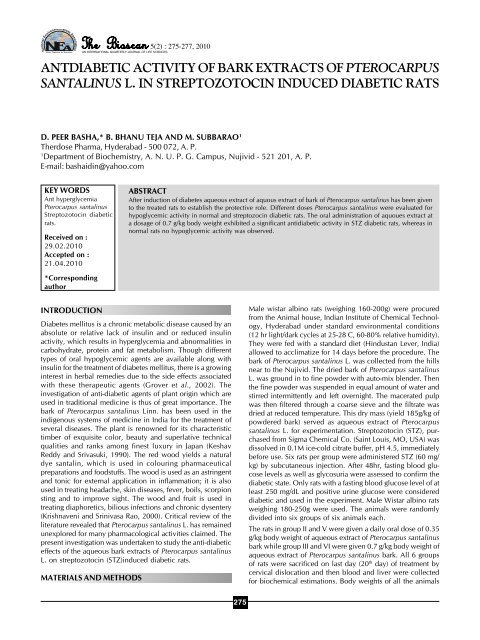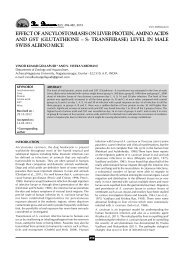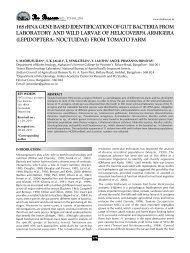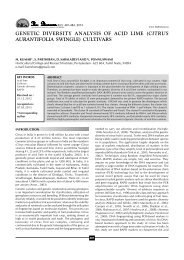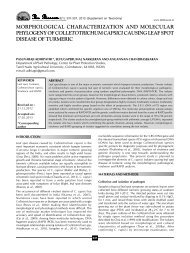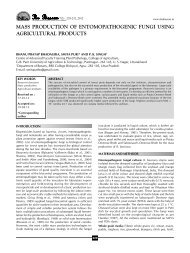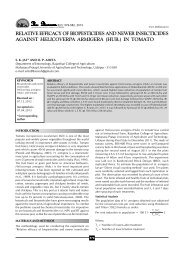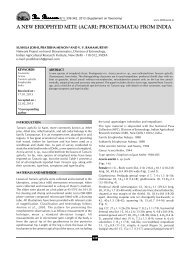full paper - THE BIOSCAN
full paper - THE BIOSCAN
full paper - THE BIOSCAN
Create successful ePaper yourself
Turn your PDF publications into a flip-book with our unique Google optimized e-Paper software.
NSave Nature to Survive<br />
5(2) : 275-277, 2010<br />
ANTDIABETIC ACTIVITY OF BARK EXTRACTS OF PTEROCARPUS<br />
SANTALINUS L. IN STREPTOZOTOCIN INDUCED DIABETIC RATS<br />
D. PEER BASHA,* B. BHANU TEJA AND M. SUBBARAO 1<br />
Therdose Pharma, Hyderabad - 500 072, A. P.<br />
1<br />
Department of Biochemistry, A. N. U. P. G. Campus, Nujivid - 521 201, A. P.<br />
E-mail: bashaidin@yahoo.com<br />
KEY WORDS<br />
Ant hyperglycemia<br />
Pterocarpus santalinus<br />
Streptozotocin diabetic<br />
rats.<br />
Received on :<br />
29.02.2010<br />
Accepted on :<br />
21.04.2010<br />
ABSTRACT<br />
After induction of diabetes aqueous extract of aquous extract of bark of Pterocarpus santalinus has been given<br />
to the treated rats to establish the protective role. Different doses Pterocarpus santalinus were evaluated for<br />
hypoglycemic activity in normal and streptozocin diabetic rats. The oral administration of aquoues extract at<br />
a dosage of 0.7 g/kg body weight exhibited a significant antidiabetic activity in STZ diabetic rats, whereas in<br />
normal rats no hypoglycemic activity was observed.<br />
*Corresponding<br />
author<br />
INTRODUCTION<br />
Diabetes mellitus is a chronic metabolic disease caused by an<br />
absolute or relative lack of insulin and or reduced insulin<br />
activity, which results in hyperglycemia and abnormalities in<br />
carbohydrate, protein and fat metabolism. Though different<br />
types of oral hypoglycemic agents are available along with<br />
insulin for the treatment of diabetes mellitus, there is a growing<br />
interest in herbal remedies due to the side effects associated<br />
with these therapeutic agents (Grover et al., 2002). The<br />
investigation of anti-diabetic agents of plant origin which are<br />
used in traditional medicine is thus of great importance. The<br />
bark of Pterocarpus santalinus Linn. has been used in the<br />
indigenous systems of medicine in India for the treatment of<br />
several diseases. The plant is renowned for its characteristic<br />
timber of exquisite color, beauty and superlative technical<br />
qualities and ranks among finest luxury in Japan (Keshav<br />
Reddy and Srivasuki, 1990). The red wood yields a natural<br />
dye santalin, which is used in colouring pharmaceutical<br />
preparations and foodstuffs. The wood is used as an astringent<br />
and tonic for external application in inflammation; it is also<br />
used in treating headache, skin diseases, fever, boils, scorpion<br />
sting and to improve sight. The wood and fruit is used in<br />
treating diaphoretics, bilious infections and chronic dysentery<br />
(Krishnaveni and Srinivasa Rao, 2000). Critical review of the<br />
literature revealed that Pterocarpus santalinus L. has remained<br />
unexplored for many pharmacological activities claimed. The<br />
present investigation was undertaken to study the anti-diabetic<br />
effects of the aqueous bark extracts of Pterocarpus santalinus<br />
L. on streptozotocin (STZ)induced diabetic rats.<br />
MATERIALS AND METHODS<br />
Male wistar albino rats (weighing 160-200g) were procured<br />
from the Animal house, Indian Institute of Chemical Technology,<br />
Hyderabad under standard environmental conditions<br />
(12 hr light/dark cycles at 25-28 C, 60-80% relative humidity).<br />
They were fed with a standard diet (Hindustan Lever, India)<br />
allowed to acclimatize for 14 days before the procedure. The<br />
bark of Pterocarpus santalinus L. was collected from the hills<br />
near to the Nujivid. The dried bark of Pterocarpus santalinus<br />
L. was ground in to fine powder with auto-mix blender. Then<br />
the fine powder was suspended in equal amount of water and<br />
stirred intermittently and left overnight. The macerated pulp<br />
was then filtered through a coarse sieve and the filtrate was<br />
dried at reduced temperature. This dry mass (yield 185g/kg of<br />
powdered bark) served as aqueous extract of Pterocarpus<br />
santalinus L. for experimentation. Streptozotocin (STZ), purchased<br />
from Sigma Chemical Co. (Saint Louis, MO, USA) was<br />
dissolved in 0.1M ice-cold citrate buffer, pH 4.5, immediately<br />
before use. Six rats per group were administered STZ (60 mg/<br />
kg) by subcutaneous injection. After 48hr, fasting blood glucose<br />
levels as well as glycosuria were assessed to confirm the<br />
diabetic state. Only rats with a fasting blood glucose level of at<br />
least 250 mg/dL and positive urine glucose were considered<br />
diabetic and used in the experiment. Male Wistar albino rats<br />
weighing 180-250g were used. The animals were randomly<br />
divided into six groups of six animals each.<br />
The rats in group II and V were given a daily oral dose of 0.35<br />
g/kg body weight of aqueous extract of Pterocarpus santalinus<br />
bark while group III and VI were given 0.7 g/kg body weight of<br />
aqueous extract of Pterocarpus santalinus bark. All 6 groups<br />
of rats were sacrificed on last day (20 th day) of treatment by<br />
cervical dislocation and then blood and liver were collected<br />
for biochemical estimations. Body weights of all the animals<br />
275
D. PEER BASHA et al.,<br />
were recorded prior to the treatment and sacrifice. Blood<br />
glucose level was determined using a glucometer Accutrend<br />
GC R (Boerhinger Mannheim, Germany) before and 48 h after<br />
STZ administration, for the confirmation of the diabetic state<br />
of animals. Glycated haemoglobin was estimated by the<br />
method of Eross et al., (1984). The estimation of glycogen in<br />
Group-I:<br />
Group_II:<br />
Group-III:<br />
Group-IV:<br />
Group-V:<br />
Group-VI:<br />
Normal rats<br />
Normal rats treated with 0.35g/kg body<br />
weight of aqueous extract of Pterocarpus<br />
santalinus bark.<br />
Normal rats treated with 0.7 g/kg body<br />
weight of aqueous extract of Pterocarpus<br />
santalinus bark.<br />
Diabetic untreated rats.<br />
Diabetic treated rats treated with 0.35g/kg<br />
body weight of aqueous extract of Pterocarpus<br />
santalinus bark.<br />
Diabetic treated rats treated with 0.7 g/kg<br />
body weight of aqueous extract of Pterocarpus<br />
santalinus bark.<br />
tissues was carried out by the method of Kemp and Van<br />
Hejnigen (1954).<br />
RESULTS AND DISCUSSION<br />
After sacrificing the rats which were given treatment with<br />
Pterocarpus santalinus aqueous extract for 20days different<br />
parameters mentioned in materials and methods were<br />
analyzed. After the treatment, body weight was measured;<br />
blood is collected and used for measuring glucose, glycated<br />
hemoglobin and glycogen content. Table 1 depicts the<br />
changes in the body weights of rats and fasting glucose levels<br />
after treatment in all 6 groups of rats. The concentration of<br />
glucose in the control sample is 82 mg /dL. Due to the induction<br />
of diabetes it has raised to the 265 mg/dL. The increased<br />
concentration of plant extract brought the glucose level to<br />
101 mg/dL. Similarly there is a decrease in the body weight by<br />
28g in diabetic animal whereas the weight gain was noticed<br />
by 20 g in normal rats. The treatment of bark aqueous extract<br />
brought the loss to 10g in the body weight. In control sample<br />
which is treated with plant extract maintained the equal weight<br />
of animal in comparision with control. Glycated hemoglobin<br />
is an indicator of the progression of diabetes. Therefore glycated<br />
hemoglobin was measured in the control and diabetic samples.<br />
In the control sample the percentage of glycosylated<br />
hemoglobin was observed to be 7.15. This induction of<br />
diabetes in the rats brought enhancement in the glycosylated<br />
hemoglobin (Table 2) from 7.15 to 12.4. This increase of<br />
glycosylated hemoglobin serves as a marker to know the<br />
induction of diabetes. The treatment of aqueous extract of PS<br />
in diabetic rats maintained the original levels of glycosylated<br />
hemoglobin equal to that of control ones. Since there is a<br />
relation between glucose content and glycogen metabolism<br />
attempts have been made to estimate the amount of glycogen<br />
in liver tissue per gram of wet tissue. In control sample 11.56<br />
mg of glycogen (glucose equivalents) was observed. In diabetic<br />
rat sample the content was reduced to 8.3 mg. This decrease<br />
in the glycogen content could be due to utilization of glucose.<br />
The PS aqueous extract treatment brought the normal levels<br />
of glycogen in diabetic rats (Table 3). The treatment of PS<br />
Table 1: Levels of glucose and changes of body weights of normal,<br />
normal treated, diabetic and diabetic treated rats<br />
Group Glucose mg/dl Change in Body weight<br />
I 82± 8.1 +20.1±5.1<br />
II 80±8.1 +20.1±4.1<br />
III 78±7.4 +20.2±5.2<br />
IV 265±10.1 -28.0±8.2<br />
V 125±10.1 -18.5±7.1<br />
VI 101±10.2 -10.±7.1<br />
aqueous extract to control ones could not influence the<br />
glycogen content.<br />
Our results suggest that the aqueous bark extracts of<br />
Pterocarpus santalinus have dose-dependent anti-diabetic<br />
activities on STZ-induced diabetes. The metabolic disturbances<br />
were corrected after the bark extracts were administered for 2<br />
weeks, as shown by the normalisation of fasting blood glucose<br />
levels, glycolated Hb, glycogen content and weight gain by<br />
diabetic-treated rats. The bark extracts appeared to have greater<br />
potency than reference drug in reducing the body weight,<br />
food and water intakes but was equipotent in blood sugar<br />
reductions.<br />
The mechanisms by which STZ brings about its diabetic state<br />
include selective destruction of pancreatic insulin secreting<br />
beta cells, which make cells less active (Junod et al., 1969;<br />
Jacot and Assal, 1989) and lead to poor glucose utilisation by<br />
tissues (Marles and Farnsworth, 1995). The aqueous bark<br />
extracts of Pterocarpus santalinus significantly reduced the<br />
high fasting glucose levels in stz-induced diabetic rats. This<br />
suggests that the extracts may possess an insulin like effect on<br />
peripheral tissues by either promoting glucose uptake and<br />
metabolism, by inhibiting hepatic gluconeogenesis (Ali et al.,<br />
1993; Gray et al., 2000) or absorption of glucose into the<br />
muscles and adipose tissues (Kamanyi et al., 1994), by the<br />
stimulation of a regeneration process and revitalization of the<br />
remaining beta cells (Shanmugasundaram et al., 1990; Rokeya<br />
Table 2: Effect of PS aqueous extract on the levels of glycated<br />
hemoglobin in different experimental animals<br />
Groups<br />
Glycated hemoglobin<br />
I 7.15±0.6<br />
II 7.16±0.7<br />
III 7.18±0.6<br />
IV 12.4±0.8<br />
V 6.5±0.5<br />
VI 7.13±0.6<br />
Table 3: Effect of PS aqueous extract on the glycogen content of<br />
different experimental animals<br />
Groups<br />
Glycogen(mg)<br />
I 11.56±0.9<br />
II 11.45± 0.8<br />
III 11.49±0.8<br />
IV 8.3 ±0.5<br />
V 9. 8±0.8<br />
VI 11.25±0.9<br />
et al., 1999; Bolkent et al., 2000). Thus the aqueous bark<br />
extracts of Pterocarpus santalinus possess anti-diabetic<br />
properties. However, we suggest that further work should be<br />
276
ANTDIABETIC ACTIVITY OF BARK EXTRACTS IN DIABETIC RATS<br />
carried out at molecular level to find out the absolute<br />
mechanism of action of the bark of Pterocarpus santalinus in<br />
experimental diabetes.<br />
REFERENCES<br />
Ali, L., Azad Khan, A. K., Mamun, M. I. R., Mosihuzzaman, M.,<br />
Nahar, N., Nur-E-Alan, M. and Rokeya, B. 1993. Studies on the<br />
hypoglycaemic effects of fruits pulp, seed and whole plant of<br />
Momordica charantia on normal and diabetic model rats. Planta<br />
Medica. 59: 408–412.<br />
Bolkent, S., Yamardag, R., Tabakogluoguz, A. and Ozsoy-Sacon, O.<br />
2000. Effects of Chord (Beta vulgaris L. var. cicla) extract on pancreatic<br />
β-cells in streptozotocin-diabetic rats: a morphologic and biochemical<br />
study. J. Ethnopharmacol. 73: 251–259.<br />
Eross, J., Kreutzmann, D., Jimenez, M., Keen, R., Rogers, S., Colwell,<br />
C., Vines, R. and Sinik, M. 1984. Colorimetric measurement of<br />
glycosylated protein in whole blood cells plasma and dried blood.<br />
Ann. Clin. Biochem. 21: 519-22.<br />
Gray, A. M., Abdel-Wahab, Y. H. A. and Flatt, P. R. 2000. The<br />
traditional plant treatment, Sabucus nigra (Elder), exhibits insulin-like<br />
and insulin releasing actions in vitro. J. Nut. 130: 15–20.<br />
Grover, J. K., Yadav, S. and Vats, V. 2002. Medicinal plants of India<br />
with anti-diabetic potential. J. Ethnopharmacol. 81: 81-100.<br />
Jacot, E. and Assal, J. P. H. 1989. Regulation de la glyc´emie. Dans:<br />
Pharmacologie des concepts Fondamentaux aux Applications<br />
Therapeutiques. Schorderet, In: Frison-Roche et Slatkine (Ed.). pp.<br />
481-494.<br />
Junod, A., Lambert, A. E., Stauffacher, W. and Renold, A. E. 1969.<br />
Diabetogenic action of streptozotocin of dose to metabolic response.<br />
J. Clin. Invest. 48: 2129–2139.<br />
Kamanyi, A., Djamen, D. and Nkeh, B. 1994. Hypoglycemic<br />
properties of the aqueous roots extract of Morinda lucida (Rubiacea)<br />
study in the mouse. Phytother. Res. 8: 369–371.<br />
Keshav Reddy, K. and Srivasuki, K. P. 1990. Vegetative propagation<br />
of red sanders (Pterocarpus santalinus L.f.). Indian Forester. 116: 536-<br />
539.<br />
Krishnaveni, K. S. and Srinivasa Rao, J. V. 2000. A new acylated<br />
isoflavone glucoside from Pterocarpus santalinus. Chem. Pharm. Bull.<br />
48: 1373-1374.<br />
Marles, R. J. and Farnsworth, N. R. 1995. Ant diabetic plants and<br />
their active constituents. Phytomed. 22: 123–189.<br />
Rokeya, B., Nahar, N., Ali, L., Hassan, Z., Nure-E-Alam, M.,<br />
Chowdhury, S. N., Azad Khan, A. K. and Mosihuzzaman, M. 1999.<br />
Effects of five medicinal plants on blood glucose levels in non-diabetic<br />
and diabetic model rats. Diabet. Res. 34: 219-228.<br />
Shanmugasundaram, E. R. B., Gopinath, K. L., Shanmugasundaram,<br />
K. R. and Rajendran, V. M. 1990. Possible regeneration of the islets of<br />
Langerhans in streptozotocin-diabetes rats given Gymnema sylvestre<br />
leaf extracts. J. Ethnopharmacol. 30: 265–279.<br />
277
278


